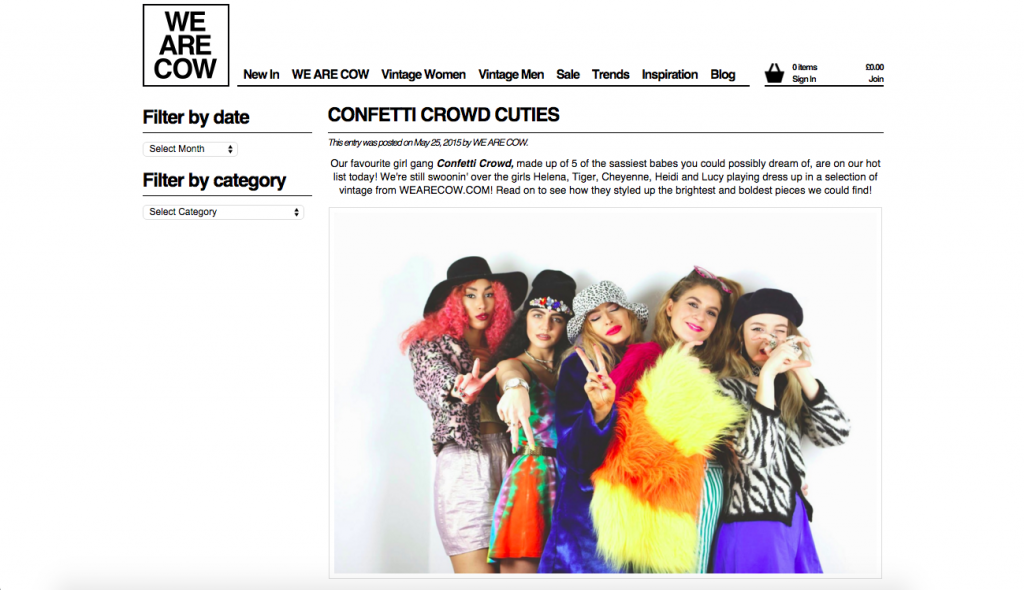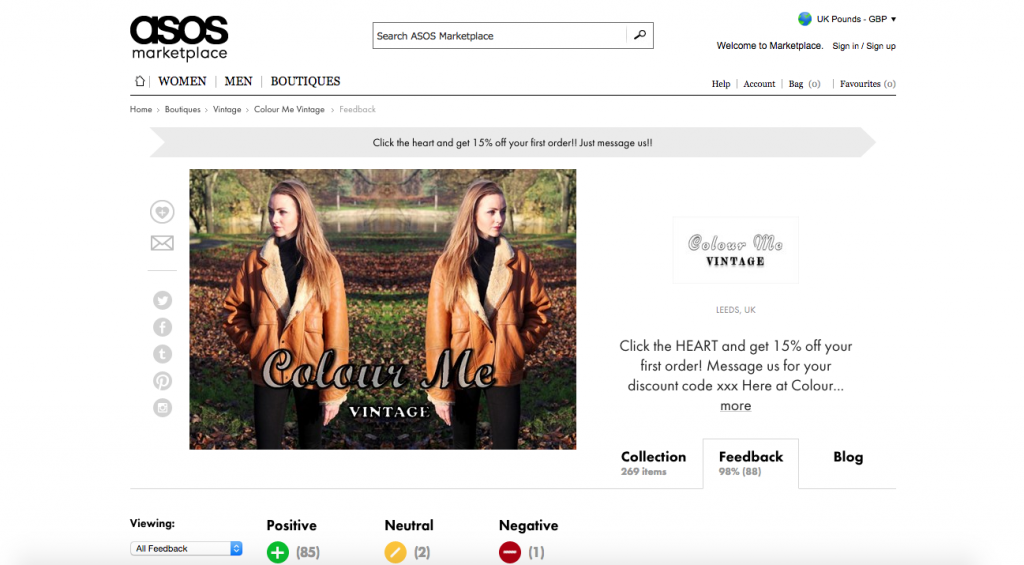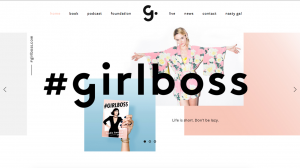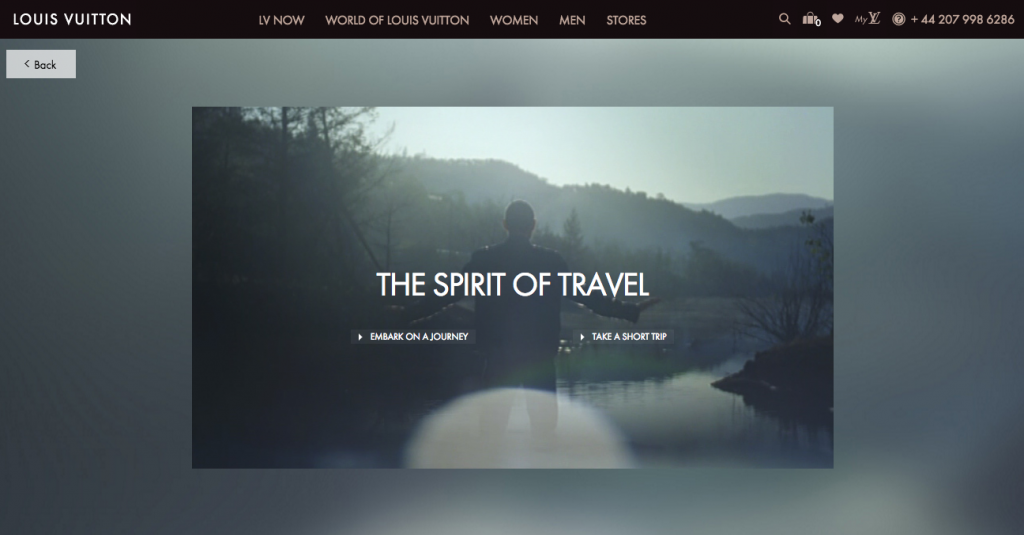According to a 2009 study by Technorati, blogs have exceeded all other Internet applications in the number of users. By 2011, the total number of blogs reached 152 million. The popularity of blogs has shifted the nature in which fashion brands communicate with their audience, as blogs today are considered the new electronic form of word-of-mouth or e-Wom (Sedeke, 2013).
A few features and functions of online communications through blogging platforms include (Okonkwo, 2010):
Transparency – people must know ‘face’ of blog, blogger must be open to all dicussions, even negative ones
Informality – the more informal: the better – if writing is ‘too smooth’ readers may not trust voice and see blog as ‘corporate ghost’
Objectivity – bloggers must be unbiased and fair, readers are quick to point out when blogger is being influenced by certain brand/company
Trust – consumers trust eachother more than press and companies, without trust, community is gone
Most fashion brands have only just caught up with bloggers. Much scepticism has been placed around the credibility of bloggers, with established brands and designers resisting to incorporate them into their corporate communication (Okonkwo, 2010). However in 2009, Burberry, known as being one of the most innovative luxury designers to use digital marketing, launched their first campaign through fashion blogs, gaining enormous success and reaching about two million page visits a day (Sedeke, 2013). This sparked interest in the blogging world and their power over the influence of the mass audience. Web 2.0 is the term that describes the second generation of Internet technologies, with lively discussions taking places on blogs, online communities, and other social media (Khamis & Munt, 2010). Alexander McQueen’s CEO claims ‘We treat respected bloggers in the same way we treat respected journalists, servicing them with information, news and images, and valuing their opinion in return.’
Benefits of working with fashion bloggers:
- Blogs can quickly react and respond to current happenings which fit well to fashion news
- Create interactive environment that serves as good marketing
- ‘Bloggers and their followers appreciate personally acquired or witnessed information more than the information coming from an official source’ (Lichtenstein, 2009)
- a ‘street of fashion,’ as a source of authenticity and a display of the actual use of fashion by the general public (Sedeke, 2013)
Below you will find 3 vintage retailers that have successfully collaborated with bloggers to communicate to their audiences:
Cow Vintage
(Target unique/quirky bloggers that fit mold of ‘We Are Cow’)
is a popular vintage retailer based in Birmingham. They pride themselves on how frequently they work with bloggers, even providing a tab on their website called ‘blog’ which consists of images and information about their collaborations with bloggers. Their most recent collaboration is with the ‘confetti crowd’ blog, which consists of 5 bloggers with diverse styles. Cow vintage decided to create a running theme in a photo shoot with the confetti girls, and invite readers to check out the ‘trends’ seen in the photo shoot on their own website. On the confetti girl’s websites, they provide images and links to Cow’s website, and their collection.

Asos Vintage Marketplace
(Own Blog)
ASOS may be ahead of their game in terms of blogging. Their approach is having their own blog ‘Marketplace Asos’, in which ‘normal’ girls wear their clothes and readers get discounts on items if they ‘like’ the ASOS blog. They feature a ‘feedback section’ and a link to the entire collection for readers to find instantly online, which allows consumers to engage with one another, creating a sense of ‘community’ around the ASOS vintage marketplace. By dividing the reviews from ‘positive’, to ‘neutral’, to ‘negative’ – the readers can choose which reviews to pay most attention to. This allows the consumer to perceive the brand as honest and transparent, therefore trusting ASOS’ online promotions.

Wolf&Gypsy Vintage
(Instagram)
This retailer based in Brighton, does minimal yet precise collaborations with bloggers, by targeting bloggers that fit the ‘personality’ of the audience they want to reach. Seen on the wolf&gypsy instagram page, their ‘regram’ of a blogger wearing an item of theirs has merely 63 likes, whereas the blogger’s own post has 647 likes. This enables wolf&gypsy to reach her audience which in fact may be much larger than their own.

Wolf & Gypsy’s Instagram VS Blogger’s Instagram – can see difference of interaction between consumers very clearly. On blogger’s post, there is much more interaction and likes. 
Critical Analysis:
Know Your Audience
According to research done by DBB London, writing as well as reading blogs are mostly done by the younger generation, with 90% of bloggers in their 20s and 79% of blog readers under the age of 40. In fact, only 70% of people in a middle class of the UK were not sure what a blog even meant. Therefore, when evaluating a blogger’s influence, it is important to remember that their reach may not be as large as a brand would like, or reach the ‘right’ audience at all. Using Wolf&Gypsy’s collaboration through Instagram, it is valuable for the brand to asses the blogger’s following, and asses whether her followers would even be aware that a brand is tagged in her post. Or perhaps the contrary, that the consumers are too ‘smart’, and would see the brand tagged in her post and choose not to click on it because they are aware that is it a promotion.
Bloggers can lose authentic voice
With increasing collaborations between brands and bloggers gaining popularity, a bloggers’ original ‘authentic’ voice may not transmit as truthfully as before. Consumers and readers are getting smarter, and will notice when a brand has paid a blogger to promote their clothing. Thoughtful and real promotion works best, and the blogger must fit the ‘customer’ that the brand wants to attract. A blogger attracts a following of similar types of readers, as these readers have similar tastes and styles or strive to be similar to the blogger. However, if the blogger posts about a brand that doesn’t suit the blogger’s style and worse, the reader’s style, readers may view blogger as a ‘corporate ghost’ and lose interest (Okonkwo, 2010). With Cow Vintage, it is great that they targeted a group of bloggers that fit the mold of different consumers, therefore attracting a larger audience, however, if Cow Vintage doesn’t fit with these bloggers’ unique styles, the promotion efforts may backfire, and readers will feel that these bloggers are only posting about Cow Vintage for profit, not through their unique voice and style. Therefore the choice of collaborations between brand and blogger have to be well thought out, and ‘authentic’ enough for the consumer to trust that the blogger’s posts are truthful.
References:
Ahmed, I. (2008). FT Report – Business of Fashion. Financial Times.
Arnardottir, B. (2016). The Business of Blogging: A Multiple Case Study. Copenhagen Business School.
Bollier, D. and Racine, L. (2005). Ready to Share: Creativity in Fashion & Digital Culture. Ready to Share.
Brown, R. (2013). Brand Interview: Cow Vintage – Blogger’s Lounge. [online] Blogger’s Lounge. Available at: http://bloggers-lounge.co.uk/blogging-tips/brand-interview-cow-vintage/ [Accessed 9 Jan. 2016].
COW, W. (2016). CONFETTI CROWD: WE ARE COW. [online] Confetticrowd.com. Available at: http://www.confetticrowd.com/2015/04/we-are-cow.html [Accessed 7 Jan. 2016].
Instagram.com, (2016). @wolfandgypsyvintage • Instagram photos and videos. [online] Available at: https://www.instagram.com/wolfandgypsyvintage/ [Accessed 5 Jan. 2016].
Khamis, S. and Munt, A. (2010). The Three Cs of Fashion Media Today: Convergence, Creativity & Control. Scan Journal, 8(2).
Marketplace.asos.com, (2016). Colour Me Vintage | Shop Skirt, Coat, Jacket, Shirt, Necklace | ASOS Marketplace. [online] Available at: https://marketplace.asos.com/boutique/colour-me-vintage [Accessed 8 Jan. 2016].
Marwick, A. (2011). Conspicuous and Authentic: Fashion Blogs, Style, and Consumption. ICA, 2(1).
Okonkwo, U. (2010). Luxury online. London: Palgrave Macmillan.
Sedeke, K. and Arora, P. (2013). Top ranking fashion blogs and their role in the current fashion industry. First Monday, 18(8).
‘Storytelling in the fashion industry can open up a world of creativity, when done right. It all begins with knowing your brand and understanding your audience. Once that is established, it’s all about making an emotional connection with your consumers,’ (Mines, 2015). This emotional connection, if done correctly, can ensure engagement in consumers and thus enhance their corporate reputation (Dijkmans, C., Kerkhof, P., & Beukeboom, C. J.,2015). Consumers are more likely to select companies with positive corporate reputations, and are willing to pay more for their products (Aula, 2010).
Before a company attempts to communicate their story digitally, it must remember that ‘people don’t buy into brands — they buy into the story behind brands’ (Mallon, 2016). Digital storytelling, combined with the power of social media, allows the brand to tap into the consumers’ emotional aspects of engagement, and create a direct link, which ideally leads to brand awareness (Juozaponyte, 2015).
Below there are three examples of fashion companies successfully executing digital storytelling:
Nastygal
In just less than 10 years, a young woman went from selling her own vintage clothing on ebay to founding what is now known as the fastest growing e-commerce site in the US. Sophia Amoruso, whether intentionally or not, has become the face of her own company. Amoruso’s story has sparked increasing interest as her company has grown over the years, with BBC calling it  ‘a Cinderella story’, which has been the centre of the company’s image ever since it was founded in 2006 (Gittleson, 2014). Amoruso used this fame to her advantage, by writing a New York Times Best Seller on success called ‘#Girlboss’, inviting fans to use this hashtag to spread awareness on social media. Nastygal’s website features links directly to the #Girlboss website, ensuring that every user that clicks on Nastygal reads its’ story to success.
‘a Cinderella story’, which has been the centre of the company’s image ever since it was founded in 2006 (Gittleson, 2014). Amoruso used this fame to her advantage, by writing a New York Times Best Seller on success called ‘#Girlboss’, inviting fans to use this hashtag to spread awareness on social media. Nastygal’s website features links directly to the #Girlboss website, ensuring that every user that clicks on Nastygal reads its’ story to success.
The Kooples
Instead of using their own story to share with their consumers, the Kooples uses the love story of real life couples or ‘Kooples’ to relate with audiences on all media channels. Each season, six new couples are chosen, with a caption of their names and how long they’ve been together for. This strategy creates an instantly relatable brand by using real, human connections that consumers can identify with, yet at the same time evoking the brands edgy personality and values. Although the couples are model look-a-likes, their relationships are just as important to the campaigns as their appearance. Using social media eff ectively, these stories are consistent but vary in detail from channel to channel. For example, a print ad will feature a picture of the couple and how long they’ve been together, and the audience is invited to check out The Koople’s Youtube channel, which features digital shorts that follow these couples around cities as they talk about their relationship directly to the camera (Walsh,2012).
ectively, these stories are consistent but vary in detail from channel to channel. For example, a print ad will feature a picture of the couple and how long they’ve been together, and the audience is invited to check out The Koople’s Youtube channel, which features digital shorts that follow these couples around cities as they talk about their relationship directly to the camera (Walsh,2012).
Louis Vuitton
This luxury fashion brand may be one of the very few of the upmarket designers to master digital storytelling and manage to communicate their values effectively. Invoking the brand’s heritage of ‘the art of travel’, with ‘Louis Vuitton Soundwalk’ –downloadable journeys through Beijing, Hong Kong, and Shanghai. Reaching out to international high profile bloggers, Louis Vuitton invited them to experience the ‘Soundwalk’ in Hong Kong, which facilitated progressive conversations around the brand. The bloggers then shared their experience with their followers through articles, comments, photos, and video footage. Luxury consumers see blogs as a more honest, reliable, and authentic source of information than the brand website (Okonkwo 2010). Therefore using bloggers to share their journey was an extremely interactive way to engage its consumers. The brand has continued to build digital journeys with its own website, http://www.louisvuittonjourneys.com. This invites consumers to go on their own journeys, and thus, share their digital story through the Louis Vuitton medium.
authentic source of information than the brand website (Okonkwo 2010). Therefore using bloggers to share their journey was an extremely interactive way to engage its consumers. The brand has continued to build digital journeys with its own website, http://www.louisvuittonjourneys.com. This invites consumers to go on their own journeys, and thus, share their digital story through the Louis Vuitton medium.
Critical Analysis:
You are NOT the Hero
It’s important for companies to remember that they are not the ‘hero’ of their story. According Ed Woodcock, all good brands understand that their customer should be the hero, with the brand’s purpose being to facilitate THEIR desires and dreams, not their own (2015). This is where Nastygal could improve. Their hero is Sophia Amoruso, and although she is incredibly inspirational, they must remember to always link it back with the consumer by relating her to their audience. Why is this story valuable to them (Klettke, 2014)? Perhaps Nastygal can improve by picking their most loyal customers each month and allowing them to share their own unique story, and make links to that of Amoruso’s. This is what the Kooples gets right in their storytelling for example, by picking ‘real’ people that their consumers may be able to relate to and connect with their consumers on a real emotional level, creating a ‘relatable’ brand.
Social Media Can Get Ugly
While social media is a great tool for reaching large audiences, it must not be forgotten that consumers have access to that exact audience as well. One bad experience can put the entire company’s reputation at risk, for example, the famous story of ‘United breaks guitars’, where one angry customer wrote a song about their experience and it reached worldwide recognition, harming United Airline’s reputation (2009). ‘Social media platforms are no orderly one-way channels for communication, but rather uncontrolled arenas for participation, which may pose a risk of reputation damage for firms (Aula, 2008)’. It is therefore important for Louis Vuitton to remember to understand their audience, and predict the contexts in which people may perceive the stories they are sharing. Thus when these bloggers share their own ‘journeys’, the content must be controlled by the brand, in order for the blogger not to experience any bad experiences along her journey. The web is known as ‘…a risky environment and corporations need to be creative as well as transparent and honest in order to captivate and communicate effectively with their various publics’ (Jones et al, 2010).
Lessons Learned:
- Consumers are much more engaged in a campaign if you evoke emotions
- But, you can only evoke emotions if the story you are telling is authentic
- Authentic story must also communicate brand’s core values
- Don’t just engage, interact with consumers – give them something to talk about
- Be Transparent to consumer – allow them to voice their opinions
- Positive/progressive conversation amongst consumers is valuable to a company’s corporate reputation
Appendix:
| The Seven Elements of Digital Storytelling |
| 1. Point of View – what is the perspective of the author? |
| 2. A Dramatic Question – a question that will be answered by the end of the story. |
| 3. Emotional Content – serious issues that speak to us in a personal and powerful way. |
| 4. The Gift of your Voice – a way to personalize the story to help the audience understand the context. |
| 5. The Power of the Soundtrack – music or other sounds that support the storyline. |
| 6. Economy – simply put, using just enough content to tell the story without overloading the viewer with too much information. |
| 7. Pacing – related to Economy, but specifically deals with how slowly or quickly the story progresses. |
(Robin, 2006)
References:
Aula, P. (2010). Social media, reputation risk and ambient publicity management. Strategy & Leadership, 38(6), pp.43-49.
Dijkmans, C., Kerkhof, P. and Beukeboom, C. (2015). A stage to engage: Social media use and corporate reputation. Tourism Management, 47, pp.58-67.
GIRLBOSS – #Girlboss is a platform inspiring women to lead deliberate lives. With intention, destiny becomes reality., (2015). home. [online] Available at: http://www.girlboss.com/ [Accessed 11 Jan. 2016].
Gittleson, K. (2016). Nasty Gal’s Sophia Amoruso: ‘Shoplifting saved my life’ – BBC News. [online] BBC News. Available at: http://www.bbc.co.uk/news/business-27414760 [Accessed 8 Jan. 2016].
Jones, B., Temperley, J. and Lima, A. (2009). Corporate reputation in the era of Web 2.0: the case of Primark. Journal of Marketing Management, 25(9-10), pp.927-939.
Juozaponyte, A. (2016). How Fashion Brands Use Digital Storytelling | 01storytelling. [online] 01storytelling.com. Available at: http://01storytelling.com/how-fashion-brands-use-digital-storytelling/ [Accessed 5 Jan. 2016].
Kiani, G. (2016). Marketing opportunities in the digital world: Internet Research: Vol 8, No 2. Internet Research, [online] 8(2), pp.185-194. Available at: http://www.emeraldinsight.com/doi/pdfplus/10.1108/10662249810211656 [Accessed 4 Jan. 2016].
Klettke, M. (2014). 3 Fatal Flaws of Failed Brand Storytelling. [online] iAcquire. Available at: http://www.iacquire.com/blog/brand-storytelling [Accessed 5 Jan. 2016].
Mallon, S. (2016). How to Use Digital Storytelling as your Social Media “Secret Sauce”. [online] Postplanner.com. Available at: https://www.postplanner.com/digital-storytelling-techniques-secret-sauce-social-media/ [Accessed 7 Jan. 2016].
McMahon, K. and Morley, J. (2016). Innovation, Interaction, and Inclusion: Heritage Luxury Brands in Collusion with the Consumer. [online] Iffti.com. Available at: http://www.iffti.com/downloads/past_conferences/IFFTI%20ABSTRACTS%20BROCHURE%202011.pdf#page=71 [Accessed 5 Jan. 2016].
Mines, R. (2015). How the Fashion Industry Wins with Marketing Storytelling | Tidal Labs. [online] Tidal Labs. Available at: https://tid.al/blog/ad-week-2015-fashion-indsutry-social-media-marketing-storytelling/ [Accessed 5 Jan. 2016].
Nastygal.com, (2016). Nasty Gals Do It Better. Shop Clothing, Shoes & Vintage | Nasty Gal. [online] Available at: http://nastygal.com [Accessed 5 Jan. 2016].
Okonkwo, U. (2010). Luxury online. London: Palgrave Macmillan.
Reinartz, W., Krafft, M. and Hoyer, W. (2004). The Customer Relationship Management Process: Its Measurement and Impact on Performance. Journal of Marketing Research, 41(3), pp.293-305.
Robin, B. (n.d.). The Educational Uses of Digital Marketing. University of Houston. [online] Available at: http://file:///Users/ErenGencler/Documents/School/Third%20Year/Digital%20Marketing/7%20Principles%20Digital%20Storytelling%20Robin.pdf [Accessed 8 Jan. 2016].
Robinson, C. (2016). Fight Club, Cinderella, and What Storytelling Means for Brands via @PostAdvertising. [online] Postadvertising.com. Available at: http://www.postadvertising.com/2012/10/what-storytelling-means-for-brands/ [Accessed 10 Jan. 2016].
Thekooples.com, (2016). The Kooples. [online] Available at: http://www.thekooples.com/en/identity/#/couples [Accessed 7 Jan. 2016].
Walsh, R. (2012). Meet the Kooples. [online] Irishexaminer.com. Available at: http://www.irishexaminer.com/lifestyle/features/meet-the-kooples-214774.html [Accessed 5 Jan. 2016].
Woodcock, E. (2014). Know your hero: ten rules of brand storytelling. [online] the Guardian. Available at: http://www.theguardian.com/media-network/marketing-agencies-association-partner-zone/ten-rules-marketing-brand-storytelling [Accessed 8 Jan. 2016].
YouTube, (2016). The Kooples. [online] Available at: https://www.youtube.com/user/TheKooplesOfficial [Accessed 27 Jan. 2016].
YouTube, (2016). United Breaks Guitars. [online] Available at: https://www.youtube.com/watch?v=5YGc4zOqozo [Accessed 30 Jan. 2016].






